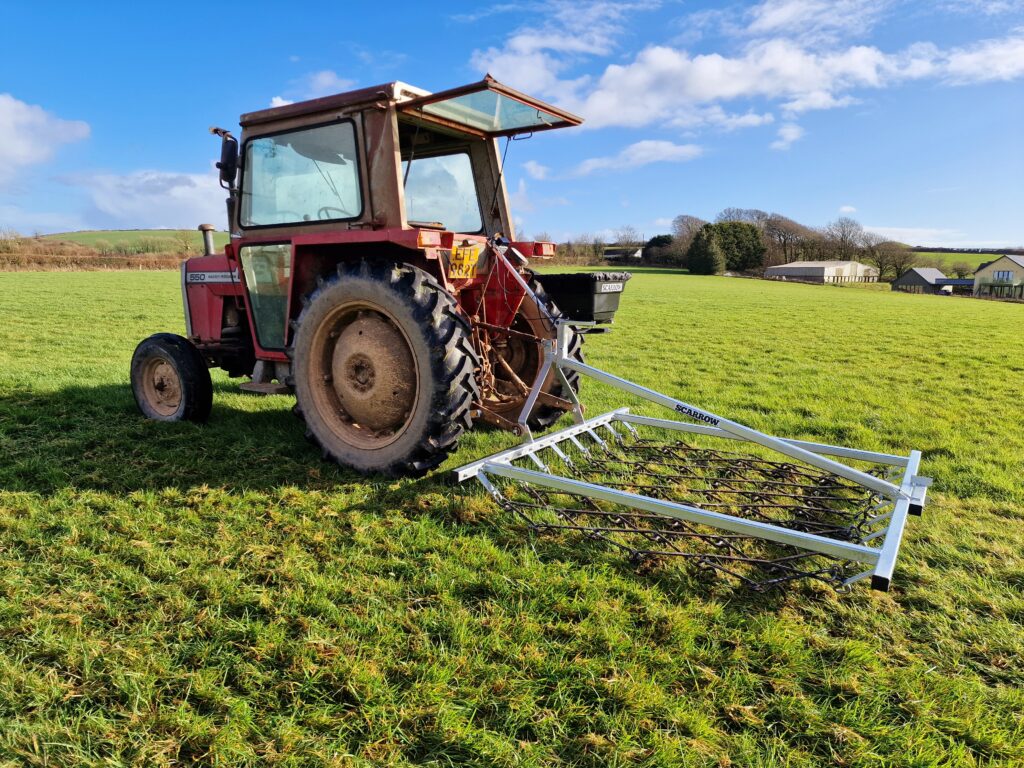
Why Harrow?
There are many benefits of harrowing established grassland. The key ones are:
- Level mole hills and other disturbed soil.
- Break up clods of earth.
- Open up compressed soil.
- Level and spread animal droppings or spread dung.
- Rip out thatch and dead grass to allow new growth to thrive.
- Rips out moss and aids drainage
- Level poached or damaged areas in preparation for re-seeding.
- Open up the sward and create bare soil in readiness for over seeding.
- Work in and cover new seed.
- Expose larvae and fungi to sunlight where it will not survive.
Harrowing is an environmentally friendly operation requiring a low power input and uses no chemicals or artificial matter.
Which type of harrow?
There are numerous harrow configurations used on grassland, the most common are:
- Chain harrow
- Tined harrow
- The new Scarrow
The most common is the traditional chain harrow which whilst it is generally effective is often found to not be aggressive enough and will ride over compacted dung or flattened mole hills. When overseeding grassland or introducing new species of herbal mixes or wildflowers the chain harrow will generally not create enough bare ground for optimal seed establishment.
The tine type harrow has gained in popularity in recent years and is more aggressive than a chain harrow provided there are sufficient tines and enough weight in the machine to allow the tines to work. There is however a tendency for dried dung to pass between the tines and remain in clods and fresh mole hills are often not sufficiently levelled as a tine simply passes through the loose soil with little effect. Small sized tined machines for use with compact tractors often lack the weight required for effective operation and the machine bounces around on the surface with little effect.
The Scarrow however is a unique combination of both tines and chain harrow mat. The leading row of tines opens up the sward, tears up compacted mole hills and mature dry dung. The chain harrow then evenly distributes that material whilst continuing the work started by the tines in tearing out thatch and moss and aerating the surface. The Scarrow is also ideal for preparing grassland for over seeding with new grass seed or introducing new species into the sward such are herbal rich mixtures and establishing wild flower meadows. The weight of the frame and chain harrow gives the tines the down force they need to operate effectively. If a less aggressive action is required the height of the machine is simply adjusted to reduce the force on the leading tines.
The optional seed broadcaster unit available for the Scarrow means that seed can be spread at the same time as harrowing in a single pass operation.
The Scarrow has been developed over several years and is protected by a UK design registration.
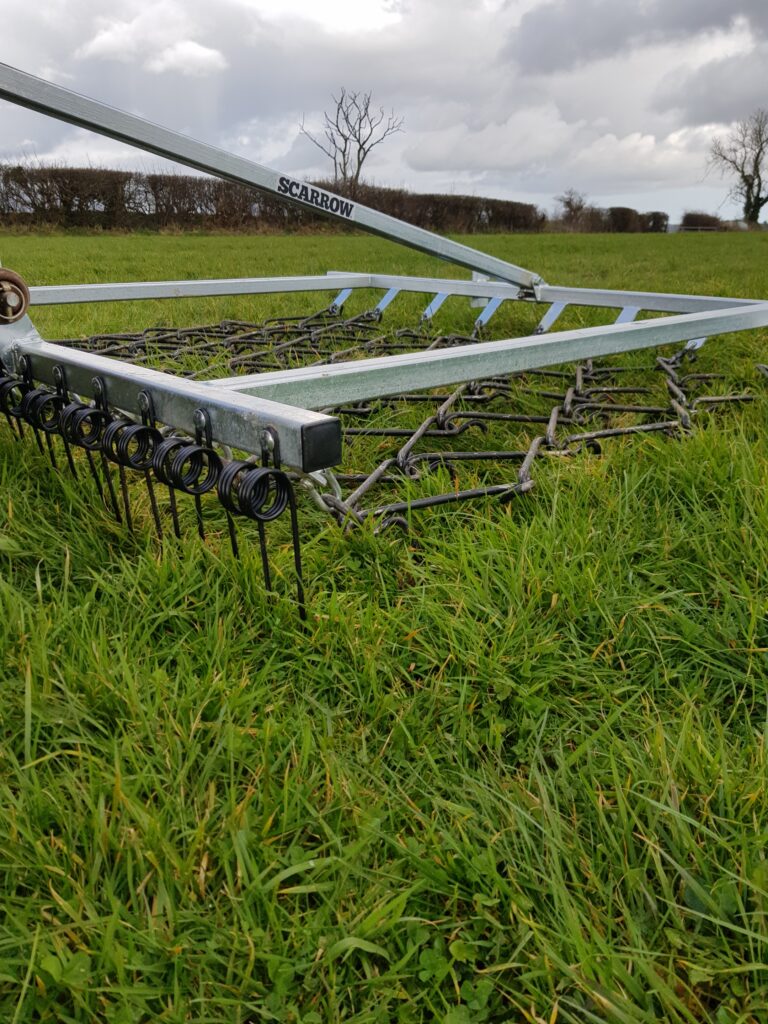

Establishing A Wild flower meadow with the Scarrow
Wild flower meadows have grown in popularity in recent years as landowners realise the environmental and aesthetic benefits of a species rich traditional meadow area on their property.
The Oxford dictionary definition of a meadow is “a field covered in grass, used especially for hay”. A wildflower meadow or traditional hay meadow is therefore grassland that is rich in species.
To help recreate this wildflower seed mixes can be introduced into grassland to enrich the diversity, however care must be taken in both the establishment and subsequent management of the meadow.
For the seed to have the best chance of germination the following conditions are required:
- Exposed but not deep cultivated soil
- Reduced competition from other plants
- Moisture
- Warmth
- Complete seed to soil contact.
Ideally a candidate site should have the majority of surface vegetation removed either by an immediately preceding hay crop or by cutting and collecting with a machine such as a flail collector. Also ground conditions should be moist but not too wet and soil temperatures should not be too low. An ideal time for this operation in the UK is late August through to the end of October though seed established after that date can still be viable provided it is not sat in waterlogged ground.
Each plot of ground and soil type is different however the Scarrow and seed broadcaster combination has been found to be highly effective in a range of conditions. Depending on the level of soil moisture it is usually best to have two passes of the Scarrow in opposite directions before spreading the seed. A third pass is then carried out with the broadcaster in operation. A fast walking pace produces good results and a two meter Scarrow can comfortably cover 3 acres an hour per pass so the operation is quite quick. The chain harrow element of the Scarrow will help cover the new seed however it is recommended that following seed sowing a pass with a lightly ballasted flat roller is carried out to complete the operation and provide the necessary seed to soil contact for optimal germination.
Establishing and maintaining a wildflower meadow is not a single event, the meadow needs to be managed and maintained. Cutting in the spring and again in late summer after the flowering season is essential. The cuttings should be removed to prevent them composting on the surface and the soil becoming too rich. One of the key advantages of the Scarrow compared to more aggressive establishment techniques such as power harrows is that further seed species can be added or the seed bank “topped up” in subsequent years by further operations of the Scarrow as by definition it will add to what is there rather than ripping it up and destroying existing vegetation.


Overseeding with the Scarrow
Overseeding existing grassland can be carried out for several reasons:
- Invigorate old pasture by adding new growth
- Repair damaged, poached or thin areas
- Add additional species such as herbal mixes to enrich the feed value particularly for horses.
- Create a wild flower meadow.
For the seed to have the best chance of germination the following conditions are required:
- Exposed but not deep cultivated soil
- Moisture
- Warmth
- Complete seed to soil contact.
Overseeding is usually carried out in the Spring of the year however it can also be effective in late Summer and early Autumn where sufficient warmth in the soil will allow germination before winter.
The Scarrow and seed broadcaster combination is an excellent machine for overseeding and has been found to be highly effective in a range of conditions. Depending on the level of soil moisture it is usually best to have one or two passes of the Scarrow in opposite directions before spreading the seed. A subsequent pass is then carried out with the broadcaster in operation. A fast walking pace produces good results and a two meter Scarrow can comfortably cover 3 acres an hour per pass so the operation is quite quick. The chain harrow element of the Scarrow will help cover the new seed however it is recommended that following seed sowing a pass with a lightly ballasted flat roller is carried out to complete the operation and provide the necessary seed to soil contact for optimal germination.
The Scarrow – Tractor Mounted SCM Series
The Scarrow is a new design of grassland harrow which has a unique combination of both tines and chain harrow mat. The leading row of tines opens up the sward, tears up compacted mole hills and mature dry dung. The chain harrow then evenly distributes that material whilst continuing the work started by the tines in tearing out thatch and moss and aerating the surface. The Scarrow is also ideal for preparing grassland for over seeding with new grass seed or introducing new species into the sward such are herbal rich mixtures and establishing wild flower meadows. The weight of the frame and chain harrow gives the tines the down force they need to operate effectively. If a less aggressive action is required the height of the machine is simply adjusted to reduce the force on the leading tines.
The optional seed broadcaster unit available for the Scarrow means that seed can be spread at the same time as harrowing in a single pass operation.
The Scarrow has been developed over several years and is protected by a UK design registration.

The Scarrow – Trailed SCT Series
The trailed version for use with quad bikes, ATV’s and small tractors continues the Scarrow concept of a combination of scarifying tines and a chain harrow. The Scarrow has proven to be more effective than a tined harrow at removing thatch, spreading dung and mole hills and preparing ground for overseeding. The 1.6m wide trailed Scarrow has a total of 96 tines and harrow teeth giving it the most comprehensive ground coverage on the market. This is further amplified by the unique harrowMAX adjustable weight transfer system which allows almost all of the frame weight and a proportion of the pulling force to be transferred onto the scarifying tines for maximum effect.
By operating a simple sliding adjustment, the amount of downforce can be reduced where a lighter touch is needed for instance when grooming a sand school or arena. Work rates of the machine are around 1.5 Ha (3.75 acres) an hour.
The Scarrow has a heavy gauge steel frame which is fully galvanised for long life. A simple spring assisted mechanical lift system allows for a low effort transition from transport to work positions. In transport mode the Scarrow rides on heavy duty wheels and tyres.
The popular Scarrow Seeder Broadcaster is also available as an option on the trailed machine. This is the ideal companion for the Scarrow for overseeding grassland, repairing damaged areas after winter or introducing herbal leys and wildflower mixes to existing pasture.
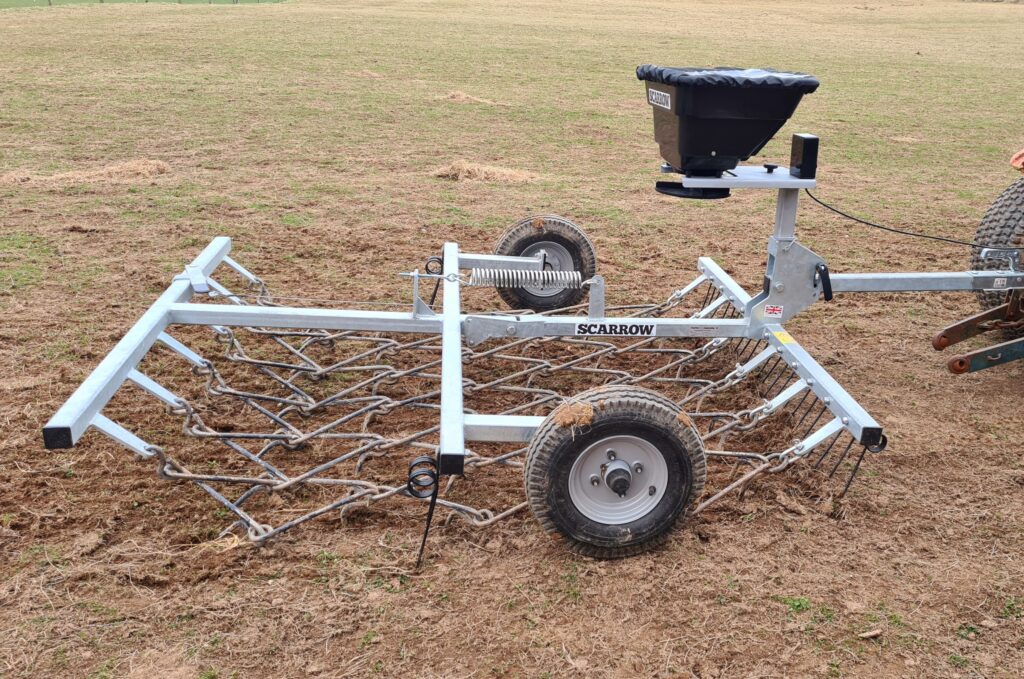
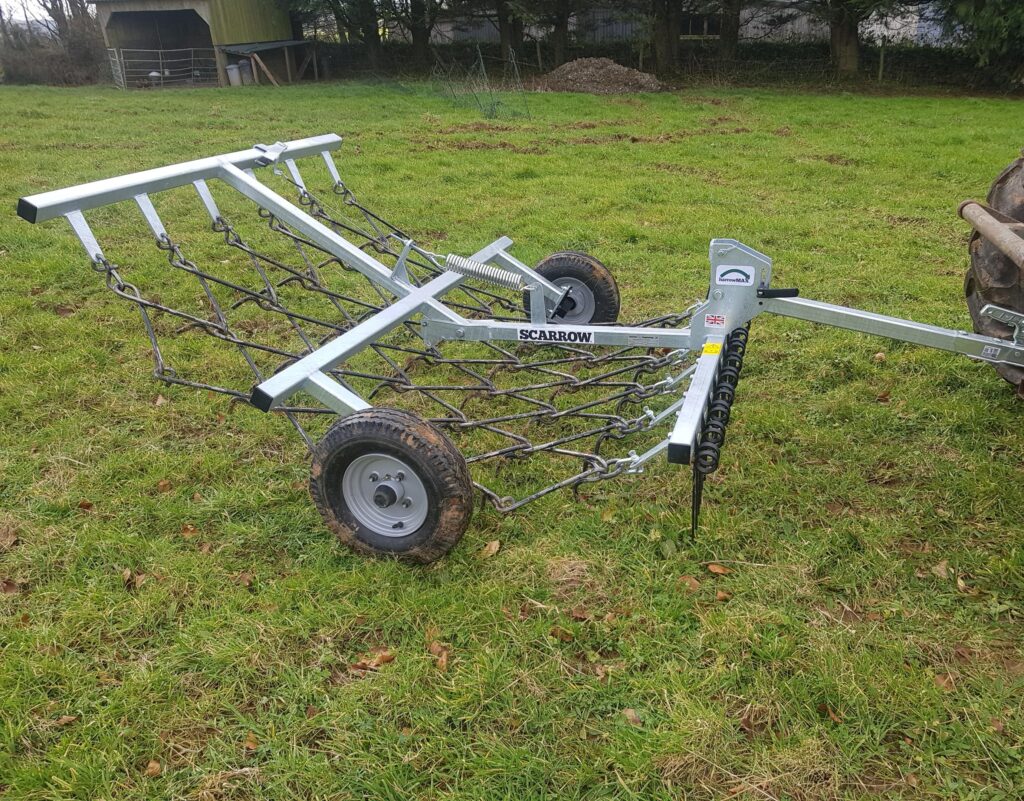
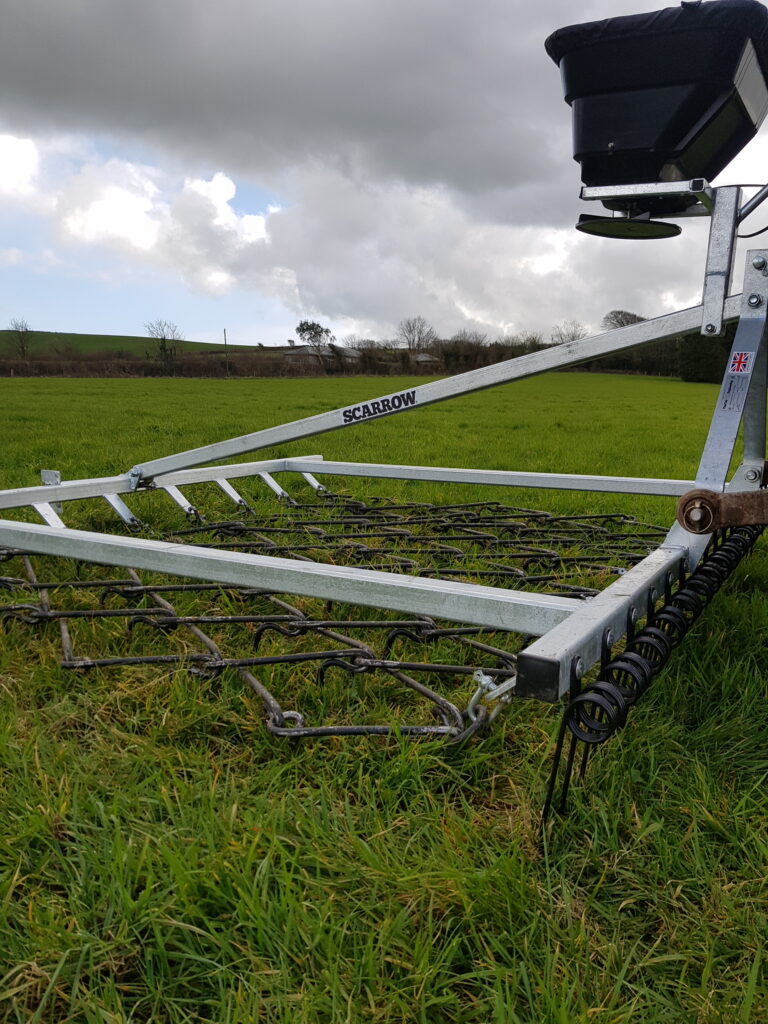
The Scarrow Seeder Broadcaster unit
The Scarrow Seeder Broadcaster unit is specifically designed for use with the Scarrow and attached to the machine frame with a single quick release pin allowing for simple removal when not in use. The broadcaster can be used with a wide range of seeds such as grass species, herbal mixes and wildflower seed. The broadcaster can also be used for low volume granular fertiliser application.
The Seeder Broadcaster consists of a hopper combined with a 12v motor driving both the seed distribution disc and a specially designed stainless steel agitator situated within the hopper. An electrically operated slide valve is situated at the base of the hopper to regulate the flow of seed or fertiliser to the distribution disc. Both the seed distribution disc and the seed regulator are controlled by a single switch from the drivers seat. Seed rate and distribution disc speed are adjustable on the machine, a digital display indicates the disc speed being used. Adjusting the disc speed allows the spread pattern to be changed to suit both machine operating width and seed type. Very light grass or wildflower seed will for instance require a higher motor speed than relatively dense prilled fertiliser. Alternatively if required the broadcaster can be used with the Scarrow raised above the ground and with the speed controller set at maximum then seed or fertiliser can be spread over a width if up to 6m.
Power for the Seeder Broadcaster is taken from the tractor or towing vehicle battery and the unit has a very low power consumption using around 3.5A.
The capacity of the Broadcaster unit is 43 litres or 35 KG which is ample for most requirements. The Seeder Broadcaster is also supplied with a transparent rain cover for the hopper.
We’ve worked with some of the best companies.
